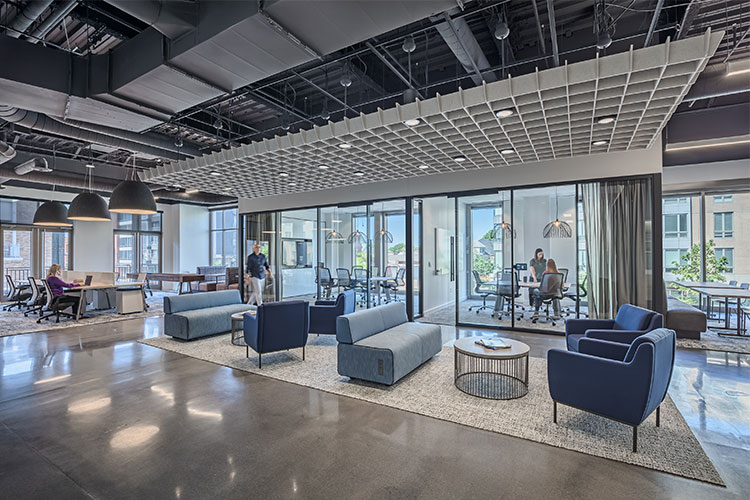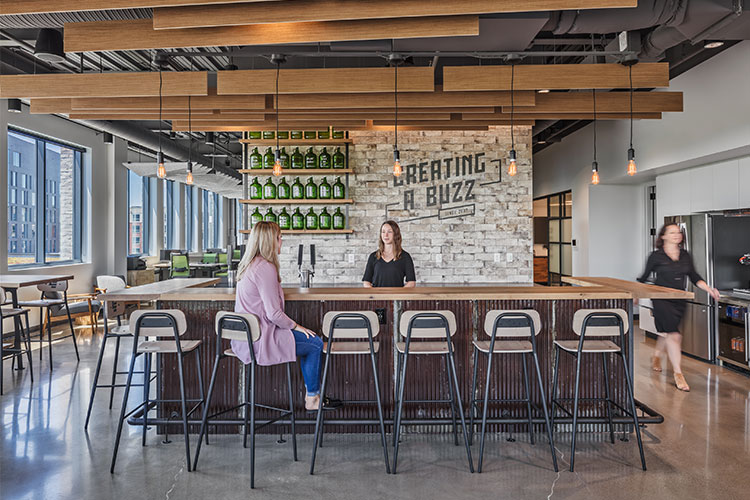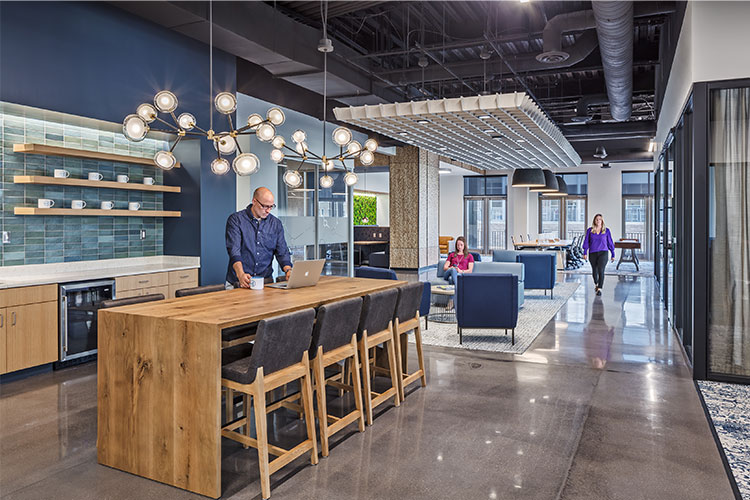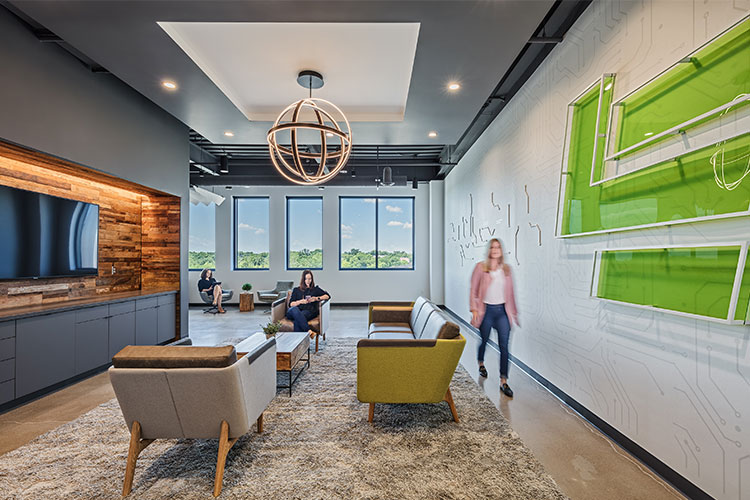As the world adjusts to work environments that balance work-from-home with in-office productivity, there are lessons to be learned about future workplace design.
By: Nikki Wildman, RA, LEED AP BD+C // Associate Principal, Project Manager
Take a moment to think back to late February. Yes, COVID-19 was newsworthy, but didn’t yet seem like a crisis. Commuters were still packed onto mass transit; offices were as busy as ever. Then, in a relative blink of an eye, all of that stopped in its tracks.
Less than three weeks later, organizations were creating entirely new workplace policies in real time — most of it shifting activity offsite. And, to the surprise of many, it worked. Leaders and employees alike rallied, learning and adjusting to new ways of working with limited or, in many cases, no access to the usual office environment.
So it’s only natural that, as workers gradually return to previous routines, many questions remain about the future of workplace design. Is benching dead? Will the pendulum finally swing back from open-office to the private office? Or even, is the office itself a thing of the past?
While most white-collar professionals have found working from home (WFH) to be a necessary stop-gap solution, a recent LinkedIn News poll found that these same professionals question their industry’s ability to work effectively in a 100% WFH arrangement in most key U.S. markets. Because for many, to do good work, proximity still matters.
As the dust settles post-pandemic, workplace designers will help organizations adjust to the new norm and plan for the future. Here are five trends we’ve observed so far.
1. In-person collaboration is still vital. But open-offices may need to adjust.
With new concerns about proximity and viral spread, aspects of open-office design have been questioned. In fact, some are asking if it ever really worked in the first place. "The Truth About Open Offices," published in the November-December 2019 Harvard Business Review, took a hard look at architecture (both building and digital) and the art of collaboration. The piece validated the benefits of more open, collaborative spaces. Researchers found that professionals can indeed thrive in an open-office environment, and teammates in close physical proximity communicated more often and more effectively than those working remotely. The challenge is doing it in a way that minimizes viral risk in the future. And that could be as simple as better awareness and practice of hygiene (washing hands, wearing masks) and creating barriers between workstations.

2. A company’s office is a key to recruiting talent.
As the lines between live, work, and play became blurred, the office has become a recruiting tool. When a professional could theoretically work from anywhere, what makes them want to spend time in the office? Designers and business owners are taking a hard look at office design and the differentiators that attract and retain the best and brightest. It’s important to think about the office as a series of culturally immersive experiences, from arrival to departure — experiences uniquely reflective of the organization’s business and brand.

3. Social spaces provide collaboration — and inspiration.
In a world where idea creation is king, office environments of successful companies include social spaces that allow for meeting flexibility and spontaneous moments of brilliance.
Social spaces such as these, whether in workplace or hospitality, tend to be spread out and naturally lend themselves to socially distanced interactions. They are safer than a crowded conference room, and contrary to those spaces, they relax users, so they can think and act more clearly. Indeed, social spaces could be a viable solution during a pandemic as they encourage communication while allowing physical distance. Comfortable employees are happier, more productive and creative. This, in turn, results in employee retention and idea creation.

4. “Resimercial” furniture is here to stay.
Hotel environments have already adopted the live/work/play concept in their design, and businesses want to quickly engage recruits and clients in comfortable work environments. While an office culture may bring people through the door, well-designed spaces and comfortable furniture invite them to stay. Over the last five years, as the desire for hospitality-type environments has grown in workplace, this trend of comfortable, durable office furniture reminiscent of that found in the living room has taken the workplace by storm. This style of furniture is a popular solution in flexible and creative work environments.

5. Safety above all else.
While the design attributes noted above may prove more useful in a blended WFH/WFO work strategy, no office will be successful without promoting the safety and health of its employees, clients and guests. Lauren Rottet, founder of international architecture and interior design firm, Rottet Studio, has an extensive portfolio of corporate, hospitality, residential, and maritime projects. In a recent webinar, she made the case that the first steps to re-entering any environment is to ensure it not only appears clean and safe, but it must function clean and safe and BE clean and safe. Companies must be transparent and authentic in achieving these goals.
Measures can be taken to promote safety and health during COVID-19. While the world waits for a vaccine or treatment, more transient details like hand sanitizer dispensers and access to PPE will be the new norm for the foreseeable future. And lessons from the not-so-distant past will prove useful after the pandemic has ended.
Touchless fixtures and occupancy sensors will be more widely adopted, with many inexpensive options now available at big box home improvement stores. Already, businesses like Hilton are using labels to ensure things like remote controls and toilet seats have been sanitized. Antimacassars (protective cloth placed over seating) were widely used in the homes of previous generations and are still common in air and train travel — perhaps there will be a modern re-invention of these furniture covers to minimize spread of infection.
With the quick adoption of WFH and new communication technologies across many industries, there is little doubt that some aspects of workplace design will change and it is still very early in what will likely be a multi-year process of learning new ways of working. And, just like a good argument between rivals, COVID-19 provides new reasons to dust-off and revisit the decades-long debate between the advantages of the open-office versus the private-office workplace.
But until there is a vaccine or treatment for COVID-19, there will continue to be more questions than answers. Before then, designers and business leaders must continue to focus on safety and what will continue to drive business: collaboration and innovation. The real magic at the office occurs in those in-between spaces where spontaneous run-ins and bright ideas happen.

Nikki Wildman, RA, LEED AP BD+C // Associate Principal, Project Manager
Nikki’s a proven team member at DesignGroup, leading and managing the delivery of projects for clients such as Leading EDJE, Franklin Park Conservatory and Cedarville University. Her insights, ideas and experience have been and will continue to be critical to the higher education, commercial and civic/cultural projects in which she services. She has also served in leadership roles for USGBC Central Ohio and DesignColumbus.
